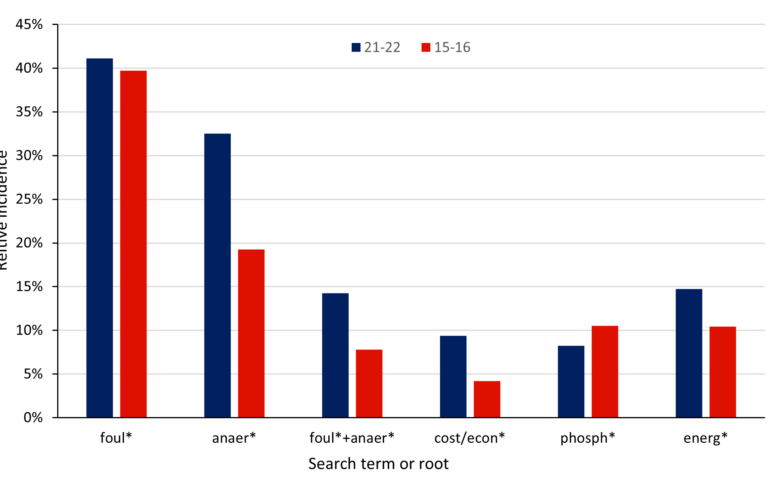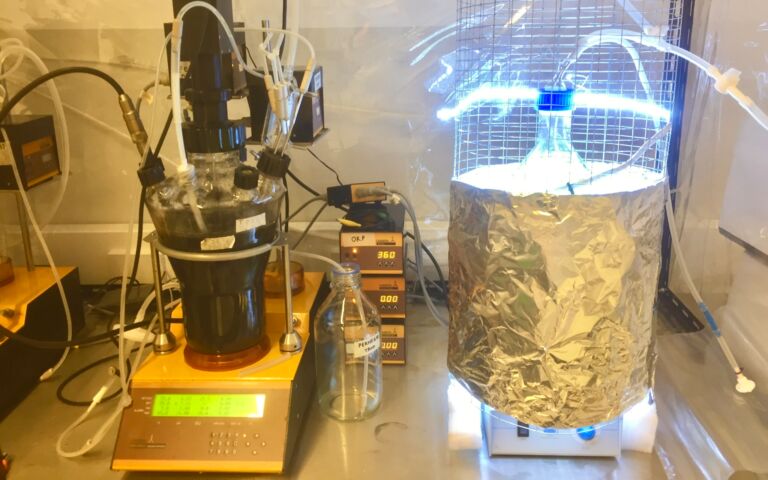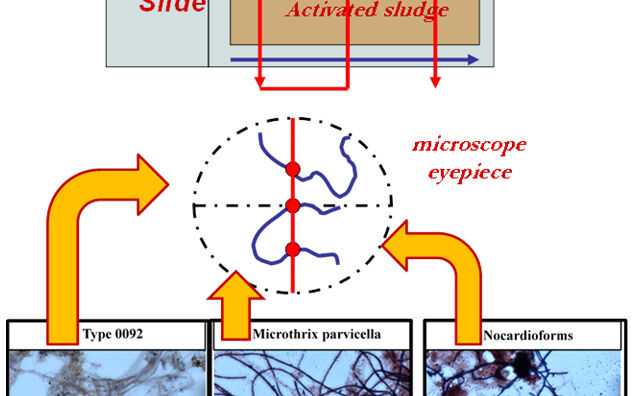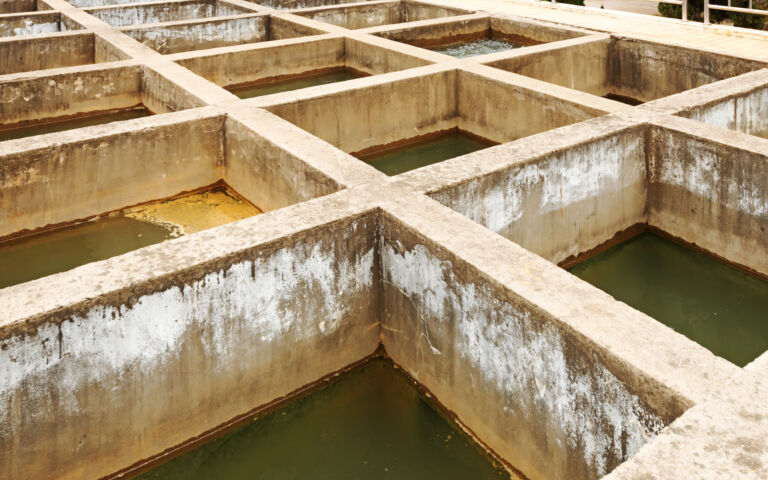Sludge characteristics: biological

1. Origins and arisings
There are essentially two different types of microorganisms of interest in MBR sludge:
- microorganisms responsible for carrying out biochemical functions, and
- pathogens.
The first of these are responsible for degrading the organic and nitrogen-containing material in the wastewater. The second can have human health impacts if ingested and are of interest if the maximum permissible concentrations for these species is specified for the treated water.
2. Biochemical functional organisms
Microorganisms and their functions
In the activated sludge process, microorganisms in the sludge feed on the organic matter in the wastewater and, in doing so, degrade them to their constituent mineral products of carbon dioxide (CO2), nitrate (NO3-) − if dissolved oxygen is present − and water. They also develop an outer layer of sticky material, referred to as ‘extracellular polymeric substances’ (EPS), which allows them to stick together (or flocculate) along with other material to form large particles known as ‘flocs’.
In a conventional activated sludge (CAS) process these flocs must be allowed to grow large enough to settle out in the secondary clarifier. In an MBR they must merely be stable and not disintegrate, since this causes the release of EPS which may then foul the membrane.
The effective removal of the organic matter through its biodegradation/mineralisation by the microorganisms relies on maintaining conditions which sustain the right sort of microorganisms. Most of the biodegradation is carried out by bacteria, which make up around 95% of the microorganisms present in the activated sludge. The remaining microorganisms are predominantly higher organisms, some of which feed on the bacteria and others on the organic matter in the wastewater.
The bacteria carry out biochemical reactions which mineralise the organic matter in the wastewater. The relative amounts of the bacteria developed (the consortia) depend on a number of factors, including the feedwater quality, reactor operating conditions, and the level of dissolved oxygen. However, overall the organic matter is either mineralised or is used to form new cells.
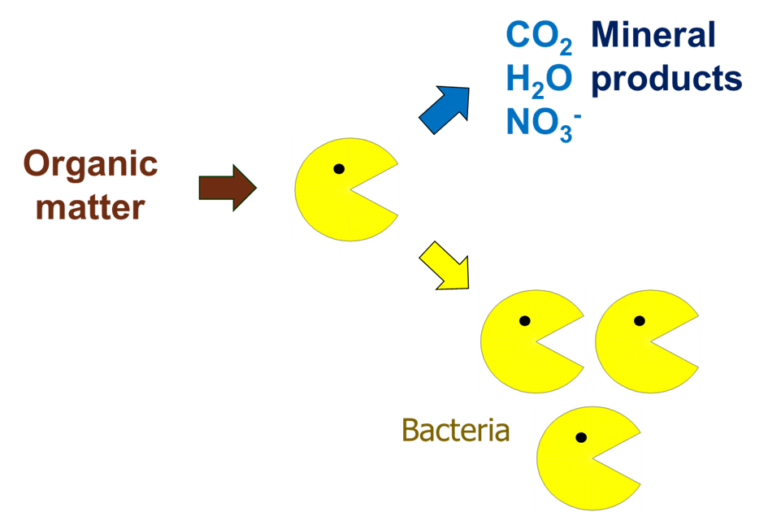
Oxidation of organic carbon is through ‘heterotrophic’ bacteria, which use organic compounds as an energy and carbon source for synthesis. Since they rely on the presence of air they are also classified as ‘aerobic’, as opposed to ‘anaerobic’ bacteria which degrade carbon in the absence of air and generate methane (CH4) rather than CO2 as the end product.
In the case of the ammonia the oxidation to nitrate takes place via two steps. In the first step ‘Nitrosonomus’ oxidise the ammonium ion (NH4+) to nitrite (NO2-). In the second step the oxidation of nitrite to nitrate is carried out by ‘Nitrobacter’. These two bacteria are collectively known as ‘nitrifying’ bacteria. They are examples of ‘autotrophic’ bacteria, and use inorganic carbon as a carbon source.
Besides the bacteria, the other microorganisms present comprise:
- protozoa, which feed off dispersed bacteria and suspended particles and so help to clarify the treated water
- metazoa, which dominate at longer solid retention times
- filamentous bacteria, which at high concentrations may cause sludge bulking (poor settling and turbid treated effluent) and foaming
- algae and fungi, where fungi may be present in older sludge.
3. Pathogens
Pathogens originate entirely from the feed sewage. They are of interest since they have health implications (see table below).
| Organism | Disease and/or symptoms |
|---|---|
| BACTERIA | |
| Salmonella sp. | Salmonellosis (food poisoning), Typhoid fever |
| Escherichia coli (enteropathogenic strains) | Gastroenteritis |
| Shigella sp. | Bacillary dysentery, severe gastroenteritis |
| Yersinia sp. | Acute gastroenteritis (including diarrhoea, abdominal pain) |
| Vibro cholerae | Cholera |
| Campylobacter jejuni | Gastroenteritis |
| ENTERIC VIRUSES | |
| Hepatitis A virus | Infectious hepatitis |
| Norwalk and Norwalk-like viruses | Epidemic gastroenteritis with severe diarrhoea |
| Rotaviruses | Acute gastroenteritis with severe diarrhoea |
| Enteroviruses | |
| Polioviruses | Poliomyelitis |
| Coxsackievirus | Meningitis, pneumonia, hepatitis, fever, cold-like symptoms, etc. |
| Echoviruses | Meningitis, paralysis, encephalitis, fever, "flu-like" symptoms, diarrhoea, etc. |
| Reovirus | Respiratory infections, gastroenteritis |
| Astroviruses | Epidemic gastroenteritis |
| Caliciviruses | Epidemic gastroenteritis |
| PROTOZOA | |
| Cryptosporidium parvum | Gastroenteritis |
| Entamoeba histolytica | Acute enteritis |
| Giardia Lamblia | Giardiasis (including diarrhoea, abdominal pain) |
| HELMINTHS | |
| Ascaris lumbricoides (Nematodes) | Ascariasis (roundworm) |
| Tainia spp. (Cestodes) | Taeniasis |
| Trichuris trichura (Nematodes) | Trichuriasis |
| Schistosoma spp. (Trematodes) | Schistosomiasis (bilharziasis) |
For the key application of potable water reuse the pathogens subject to regulatory limits are enteroviruses, E Coli, and the protozoa Giardia and Cryptosporidium, including oocysts. Enteroviruses are relatively small (<0.05 µm) compared with E Coli (1-2 µm) or the protozoa (>4 µm), but are
- largely associated with suspended solids (SS) – particularly in high-SS environments such as mixed liquors – and
- less tolerant to chemical disinfection than the protozoa and cryptosporidium oocysts specifically.
In potable reuse it is normally the removals and residual levels of enteroviruses and protozoa which are regulated. This then takes account of removal on the basis of size exclusion (such as for membranes) and physicochemical mechanisms such as ultraviolet and chemical disinfection.
Almost all potable water reuse plants installed worldwide are based on classical wastewater treatment, most usually using the conventional activated sludge (CAS) process, with downstream ‘polishing’. Polishing often involves membrane technology and UV irradiation.





